Year in Review 2004-2005
July 2004
UW–Madison scientists team with an information technology company to build an online, publicly accessible library of data on infectious agents and their genomes. The resource consolidates information about enterobacteria, a group of pathogens that can cause diseases such as dysentery, plague and typhoid fever, and others that could be used as biological weapons.
The PEOPLE program, one of the UW–Madison’s cornerstone diversity efforts, is in full swing, with more than 850 middle and high school students attending workshops, classes and enrichment programs on campus during the summer. Founded in 1999, this groundbreaking partnership between the university and Wisconsin public schools creates a “pipeline” of students of color who are developing critcial academic skills, participating in enrichment opportunities and becoming familiar with the college experience.
The Office of Corporate Relations launches the UW Business News Wire to distribute news and other information from the university that may be of interest to the business community.
August 2004
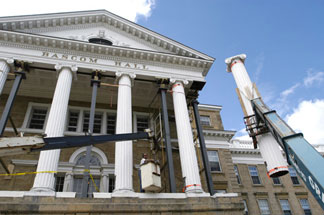
Renovation of the Bascom Hall portico
Work begins on the white–columned Bascom Hall portico. The project will repair damage to the wooden bases and tops of the portico’s six 22–foot–tall, bald–cypress columns and two rectangular half–columns. Also to be replaced are deteriorated Madison sandstone around the building’s main entrance, the hall’s front steps and lighting around the entrance.
The last of the university’s 15 Quonset huts is razed. In 1945–46, the university’s enrollment doubled, and the huts became a fast solution to a space shortage. The “temporary” structure was part of the campus for more than 60 years. In time, some of the now–available space may be used for an expansion of the Education Building, but a majority of the area likely will become green space.
Gary Sandefur, professor and incoming chair of the Department of Sociology, is named dean of the College of Letters and Science, the university’s largest academic unit with more than 39 departments, five professional schools, and nearly 60 interdisciplinary research and teaching programs. He succeeds Phillip Certain, who retired after 34 years with the university.
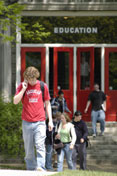
Among the best
UW–Madison remains the seventh–best public university and tied for 32nd–best overall university in the 2005 edition of U.S. News and World Report’s “America’s Best Colleges.” The university did particularly well in the area of peer assessment, and was mentioned in other U.S. News unranked lists, including those for first–year experiences, undergraduate research/creative projects, learning communities and study abroad.
The Board of Regents approves a 2005–07 budget request that would help UW System’s 26 campuses and UW–Extension begin to recover from the $250 million in state budget cuts they took in the 2003–05 biennium. The board requests an average annual increase of $105.8 million in state tax dollars and student fees; the proposal would require a 7.2 percent increase in state support and a 4.3 percent annual tuition increase.

Camp Randall on a football Saturday
Several changes to campus are apparent at the start of the 2004–05 academic year. Camp Randall Stadium and the Kohl Center boast new scoreboards as renovation on Camp Randall continues. City and state officials approve construction of a 425–bed residence hall (the first to be added to campus since 1986), plus a UW office building, visitor center and parking garage on Park Street, just north of Regent Street. The new hall will allow for a planned demolition of Ogg Hall in 2007.
The School of Business is ready to begin its new, innovative MBA program, which allows students to focus their graduate school experience in one of 14 career specializations, including areas such as applied corporate finance, supply chain management, and brand and product management.
Piazza Italia, a new residential program, gets under way in Adams Hall, allowing students to immerse themselves in Italian. A native speaker of Italian also will be living with the students to assist with language skills and help coordinate special programming. Piazza Italia joins Spanish and German programs in the International Learning Community.
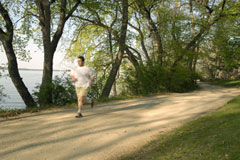
Howard Temin Lakeshore Path
Most of the construction work that closed parts of the Howard Temin Lakeshore Path during the spring and summer is finished, including a stretch from Oxford Road in Shorewood Hills to the Willow Creek bridge behind the Natatorium.
Kevin Reilly, chancellor and former provost of UW–Extension, is appointed by the Board of Regents as the sixth UW System president. He succeeds Katharine Lyall, who retired after nearly 13 years in the position.
Kim Moreland is named the new director of Research and Sponsored Programs, which oversees the administration of outside grants and awards. Moreland, previously the director of grant and contract administration at a Seattle cancer research center, says that she hopes to enhance partnerships with research faculty and the people who support their work on and off campus.
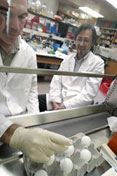
Influenza research
A study led by UW–Madison virologist Yoshihiro Kawaoka shows that the influenza virus may be outsmarting an antiviral drug that was envisioned as a main defense in the event of a flu pandemic. A study of Japanese children with influenza and treated with the drug oseltamivir showed that nearly 20 percent of these patients produced mutant drug–resistant viruses within as soon as four days. Kawaoka emphasizes that although the emergence of resistant flu virus was worrisome, the compound oseltamivir is still a valuable therapeutic drug.
Aimed at streamlining the process, the Office of Student Financial Services adds a feature allowing students to manage their financial–aid awards through the My UW–Madison portal. In addition to the portal access, students also will receive notification of their financial–aid packages via their campus e–mail accounts.
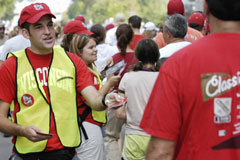
A Fan Ambassador welcomes sports fans
UW–Madison begins “Rolling Out the Red Carpet” to build new, welcoming traditions for sports fans. The initiative responds to complaints about fan conduct during the 2003 football season and encourages a friendlier welcome to all fans, regardless of the team they support. The effort focuses initially on football, hockey and basketball. Volunteer “Fan Ambassadors,” wearing bright green vests and armed with giveaways and information, greet fans as they approach Camp Randall Stadium.
A team of UW researchers led by Jeff Johnson, an associate professor in the School of Pharmacy, discovers that increased expression of a protein called transthyretin in the brain appears to halt the progression of Alzheimer’s disease.
The School of Nursing hosts three professors from Japan, with the goal of laying groundwork for an international partnership. Such a partnership would offer possibilities for joint research and student exchange, and the university would help Japan’s Kyushu International College of Nursing develop a graduate program.
The university is named to lead an alliance of 21 state colleges and universities aimed at increasing the number of underrepresented minorities who receive bachelor’s degrees in the science, technology, engineering and math disciplines. A $2.5 million grant from the Louis Stokes Alliances for Minority Partnerships forms the UW–Madison–led Wisconsin Alliance for Minority Participation.
September 2004
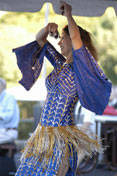
World Music Festival
Residents of Sellery Hall attempt to get into the Guinness Book of World Records by conducting the largest game of “telephone” ever. More than half of the hall’s 1,100 residents participate in the game that begins with the message “Go Big Red” and ends with “UW–Madison rocks.”
The first World Music Festival debuts on campus, offering Basque dance music, a Romany brass band, Brazilian jazz, Whirling Dervishes and Creole music.
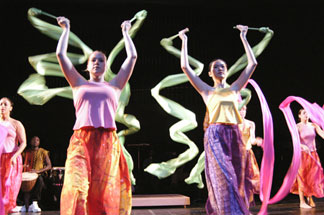
Students perform at the Overture Center
Dozens of UW–Madison students from the Dance Program, School of Music Symphony Orchestra, University Opera and University Theatre perform in the celebration of the opening of Madison’s Overture Center. The newly opened center also includes the James Watrous Gallery, dedicated to the man who painted the Paul Bunyan scenes in the Memorial Union, and created mosaics in the Social Science Building, Memorial Library and outside Vilas Hall.
The School of Human Ecology receives an $8 million lead gift for an addition and remodeling of its historic building from Nancy Johnson Nicholas and her husband, Albert Nicholas. The improved facilities will accommodate all of the school’s functions within a single building.
W. Charles Read, dean of the School of Education since 1995, announces his June retirement. Under his leadership, the school’s teacher–preparation programs were revised to base certification on performance, key external relationships were strengthened, and externally funded research and public service increased.
More faculty from the School of Social Work are funded as Hartford Geriatric Social Work Faculty Scholars and serve as national mentors than any other school. The faculty focus on encouraging student interest in the aging population, incorporating content about gerontology into the social work curriculum and conducting research on gerontology.
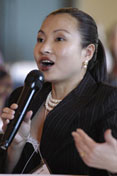
Plan 2008 forum
Students, faculty, staff and the community identify “missing pieces” in UW–Madison’s efforts to strengthen diversity and improve campus climate at the fifth annual Plan 2008 Campus Forum.
The university announces that a yearlong process will create a master plan to guide campus renewal into the next decade. This effort will examine existing and proposed buildings, outdoor spaces, transportation and utilities for future improvements.
The Class of 2008 enters the university with the highest average class rank, grade–point average and composite test scores of any class in the institution’s history. More than half of new freshmen — 54 percent — graduated in the top 10 percent of their high school classes. Total enrollment is expected to be 41,141.
Continue to October–December 2004 »